Critical Appraisal of Qualitative and RCT Healthcare Research Studies
VerifiedAdded on 2021/05/31
|16
|4189
|137
Report
AI Summary
This report provides a critical appraisal of two research studies. The first study, a qualitative study, investigates the barriers and facilitators experienced by family carers making decisions for individuals with dementia who lack capacity, focusing on the UK's legislative context and the challenges of proxy decision-making. The second study is a randomized controlled trial (RCT) that compares the effectiveness of tai chi versus aerobic exercise for fibromyalgia, examining the interventions' impact, duration, and dosage. The appraisal assesses the methodological rigor, ethical considerations, potential biases, and the value of each study's findings. The report meticulously examines the research designs, participant selection, data collection methods, analysis techniques, and the overall significance of the studies in their respective fields. It highlights the strengths and weaknesses of each study, providing a comprehensive evaluation of their contributions to healthcare research and practice.
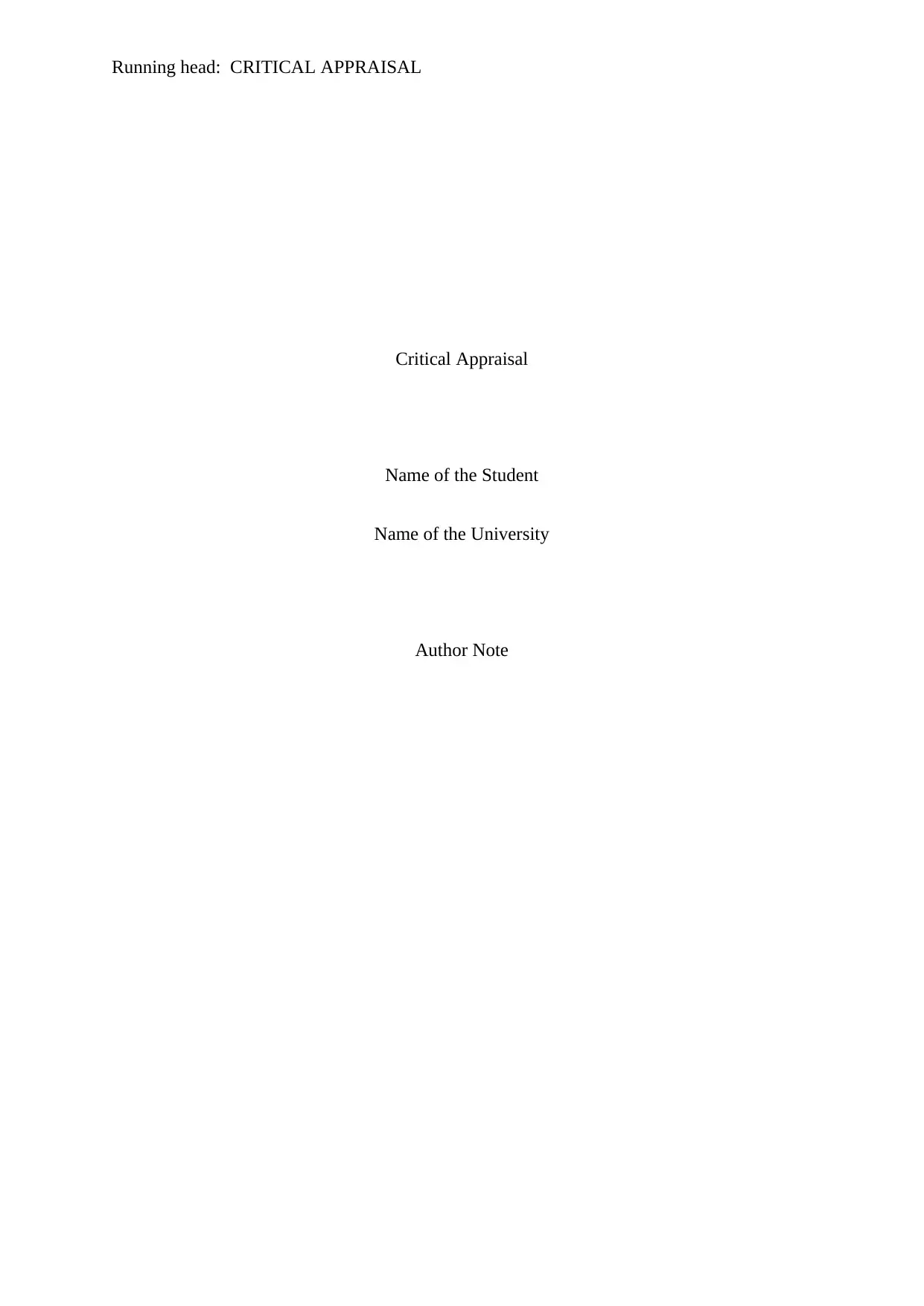
Running head: CRITICAL APPRAISAL
Critical Appraisal
Name of the Student
Name of the University
Author Note
Critical Appraisal
Name of the Student
Name of the University
Author Note
Paraphrase This Document
Need a fresh take? Get an instant paraphrase of this document with our AI Paraphraser
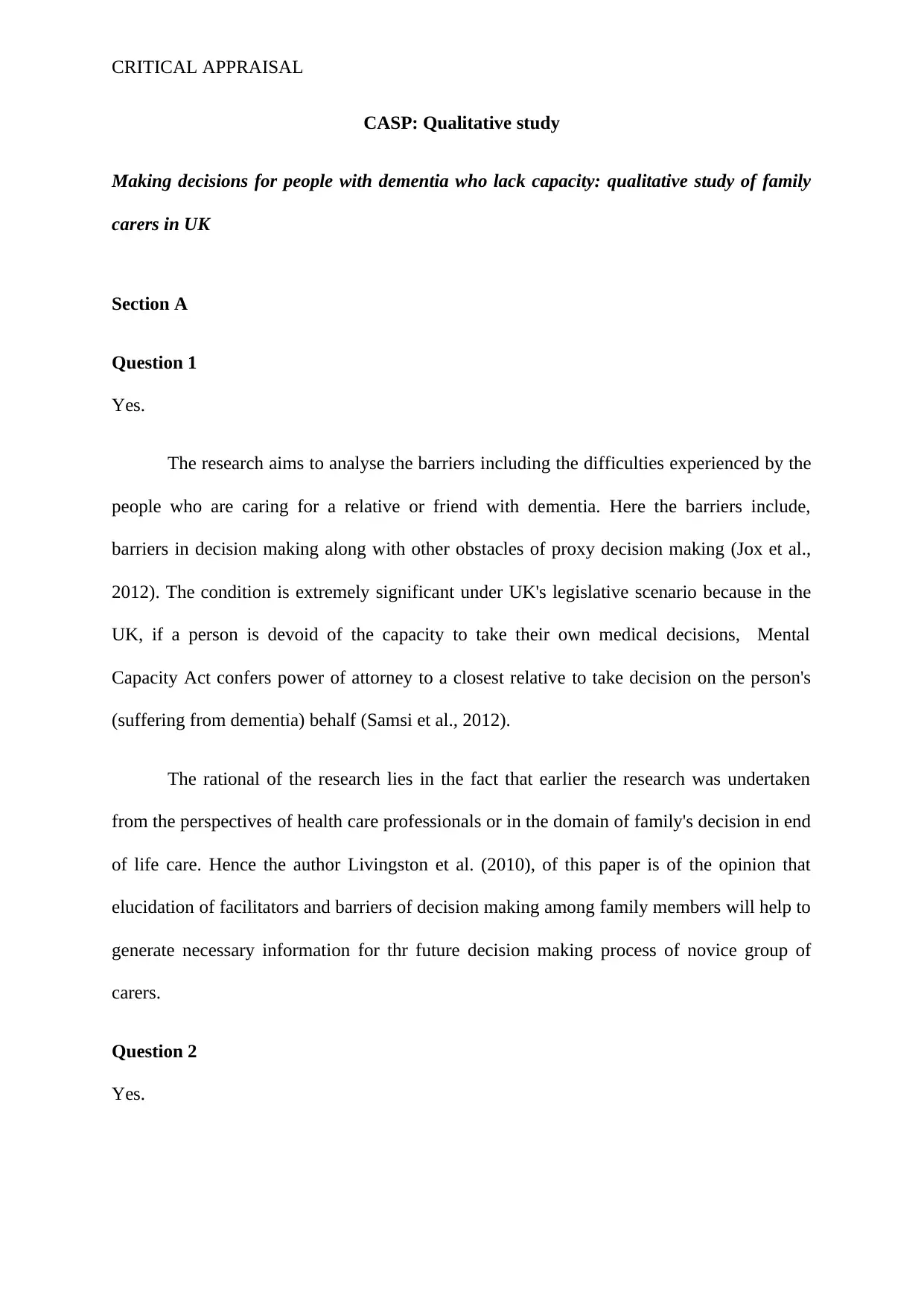
CRITICAL APPRAISAL
CASP: Qualitative study
Making decisions for people with dementia who lack capacity: qualitative study of family
carers in UK
Section A
Question 1
Yes.
The research aims to analyse the barriers including the difficulties experienced by the
people who are caring for a relative or friend with dementia. Here the barriers include,
barriers in decision making along with other obstacles of proxy decision making (Jox et al.,
2012). The condition is extremely significant under UK's legislative scenario because in the
UK, if a person is devoid of the capacity to take their own medical decisions, Mental
Capacity Act confers power of attorney to a closest relative to take decision on the person's
(suffering from dementia) behalf (Samsi et al., 2012).
The rational of the research lies in the fact that earlier the research was undertaken
from the perspectives of health care professionals or in the domain of family's decision in end
of life care. Hence the author Livingston et al. (2010), of this paper is of the opinion that
elucidation of facilitators and barriers of decision making among family members will help to
generate necessary information for thr future decision making process of novice group of
carers.
Question 2
Yes.
CASP: Qualitative study
Making decisions for people with dementia who lack capacity: qualitative study of family
carers in UK
Section A
Question 1
Yes.
The research aims to analyse the barriers including the difficulties experienced by the
people who are caring for a relative or friend with dementia. Here the barriers include,
barriers in decision making along with other obstacles of proxy decision making (Jox et al.,
2012). The condition is extremely significant under UK's legislative scenario because in the
UK, if a person is devoid of the capacity to take their own medical decisions, Mental
Capacity Act confers power of attorney to a closest relative to take decision on the person's
(suffering from dementia) behalf (Samsi et al., 2012).
The rational of the research lies in the fact that earlier the research was undertaken
from the perspectives of health care professionals or in the domain of family's decision in end
of life care. Hence the author Livingston et al. (2010), of this paper is of the opinion that
elucidation of facilitators and barriers of decision making among family members will help to
generate necessary information for thr future decision making process of novice group of
carers.
Question 2
Yes.
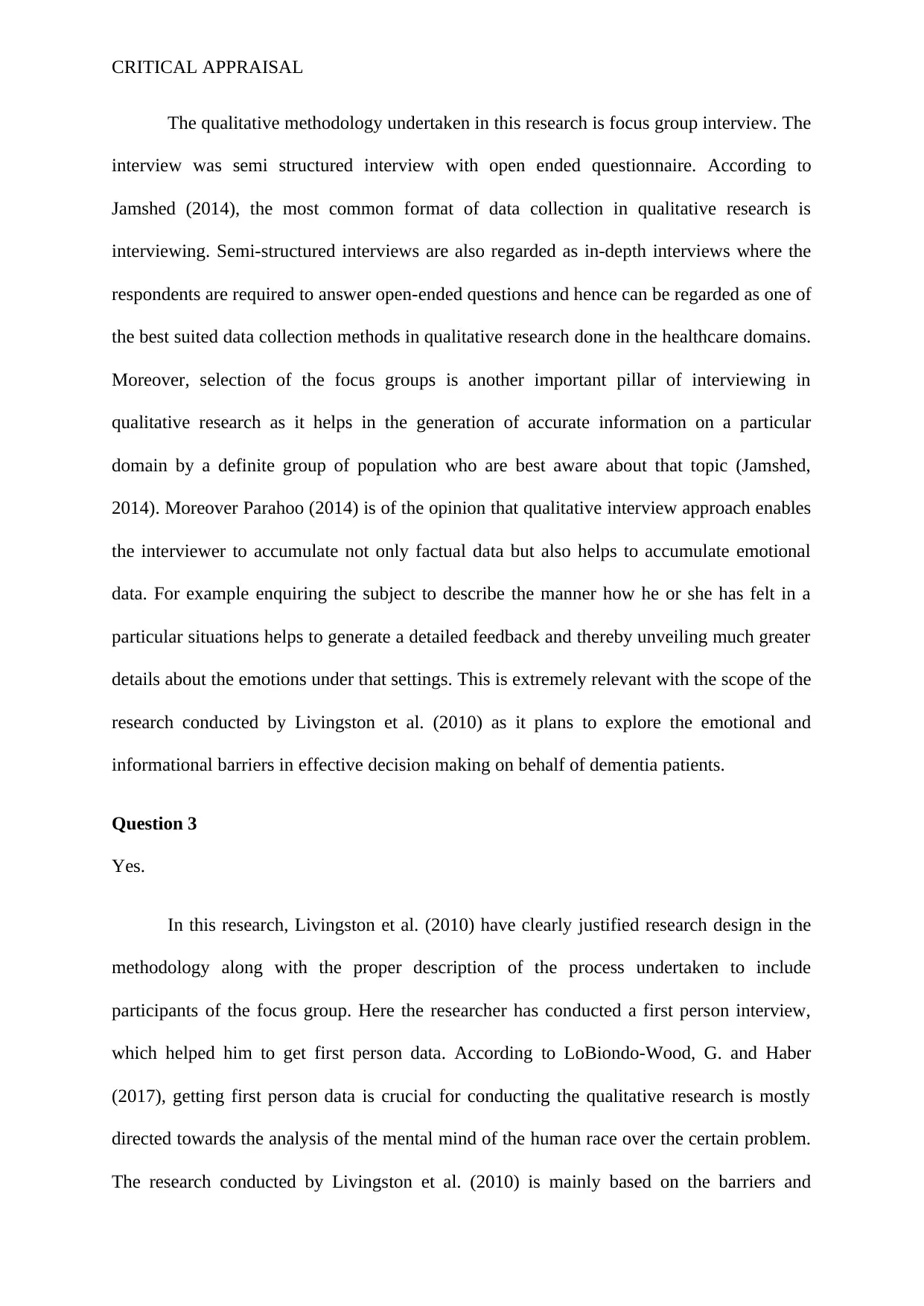
CRITICAL APPRAISAL
The qualitative methodology undertaken in this research is focus group interview. The
interview was semi structured interview with open ended questionnaire. According to
Jamshed (2014), the most common format of data collection in qualitative research is
interviewing. Semi-structured interviews are also regarded as in-depth interviews where the
respondents are required to answer open-ended questions and hence can be regarded as one of
the best suited data collection methods in qualitative research done in the healthcare domains.
Moreover, selection of the focus groups is another important pillar of interviewing in
qualitative research as it helps in the generation of accurate information on a particular
domain by a definite group of population who are best aware about that topic (Jamshed,
2014). Moreover Parahoo (2014) is of the opinion that qualitative interview approach enables
the interviewer to accumulate not only factual data but also helps to accumulate emotional
data. For example enquiring the subject to describe the manner how he or she has felt in a
particular situations helps to generate a detailed feedback and thereby unveiling much greater
details about the emotions under that settings. This is extremely relevant with the scope of the
research conducted by Livingston et al. (2010) as it plans to explore the emotional and
informational barriers in effective decision making on behalf of dementia patients.
Question 3
Yes.
In this research, Livingston et al. (2010) have clearly justified research design in the
methodology along with the proper description of the process undertaken to include
participants of the focus group. Here the researcher has conducted a first person interview,
which helped him to get first person data. According to LoBiondo-Wood, G. and Haber
(2017), getting first person data is crucial for conducting the qualitative research is mostly
directed towards the analysis of the mental mind of the human race over the certain problem.
The research conducted by Livingston et al. (2010) is mainly based on the barriers and
The qualitative methodology undertaken in this research is focus group interview. The
interview was semi structured interview with open ended questionnaire. According to
Jamshed (2014), the most common format of data collection in qualitative research is
interviewing. Semi-structured interviews are also regarded as in-depth interviews where the
respondents are required to answer open-ended questions and hence can be regarded as one of
the best suited data collection methods in qualitative research done in the healthcare domains.
Moreover, selection of the focus groups is another important pillar of interviewing in
qualitative research as it helps in the generation of accurate information on a particular
domain by a definite group of population who are best aware about that topic (Jamshed,
2014). Moreover Parahoo (2014) is of the opinion that qualitative interview approach enables
the interviewer to accumulate not only factual data but also helps to accumulate emotional
data. For example enquiring the subject to describe the manner how he or she has felt in a
particular situations helps to generate a detailed feedback and thereby unveiling much greater
details about the emotions under that settings. This is extremely relevant with the scope of the
research conducted by Livingston et al. (2010) as it plans to explore the emotional and
informational barriers in effective decision making on behalf of dementia patients.
Question 3
Yes.
In this research, Livingston et al. (2010) have clearly justified research design in the
methodology along with the proper description of the process undertaken to include
participants of the focus group. Here the researcher has conducted a first person interview,
which helped him to get first person data. According to LoBiondo-Wood, G. and Haber
(2017), getting first person data is crucial for conducting the qualitative research is mostly
directed towards the analysis of the mental mind of the human race over the certain problem.
The research conducted by Livingston et al. (2010) is mainly based on the barriers and
⊘ This is a preview!⊘
Do you want full access?
Subscribe today to unlock all pages.

Trusted by 1+ million students worldwide
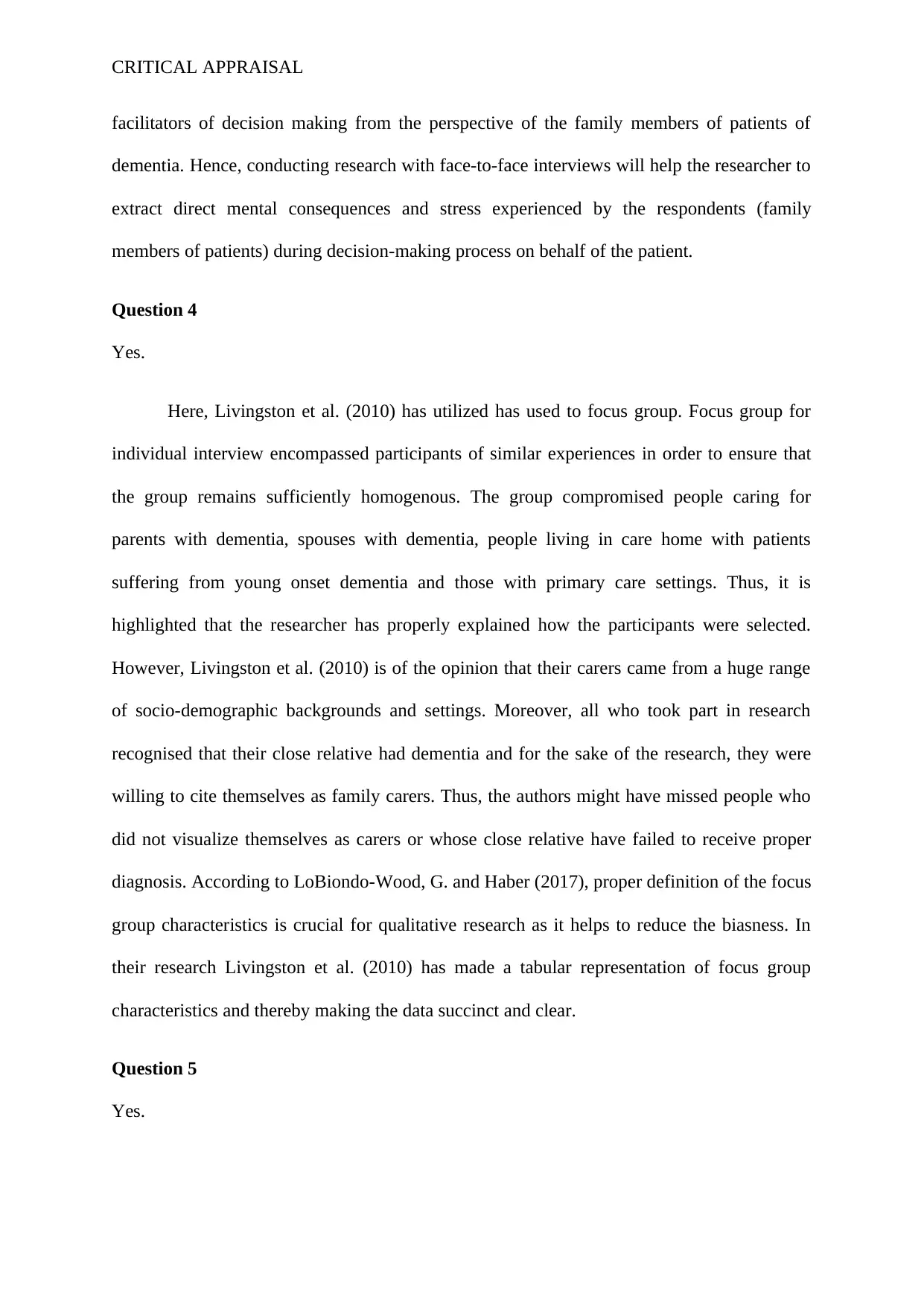
CRITICAL APPRAISAL
facilitators of decision making from the perspective of the family members of patients of
dementia. Hence, conducting research with face-to-face interviews will help the researcher to
extract direct mental consequences and stress experienced by the respondents (family
members of patients) during decision-making process on behalf of the patient.
Question 4
Yes.
Here, Livingston et al. (2010) has utilized has used to focus group. Focus group for
individual interview encompassed participants of similar experiences in order to ensure that
the group remains sufficiently homogenous. The group compromised people caring for
parents with dementia, spouses with dementia, people living in care home with patients
suffering from young onset dementia and those with primary care settings. Thus, it is
highlighted that the researcher has properly explained how the participants were selected.
However, Livingston et al. (2010) is of the opinion that their carers came from a huge range
of socio-demographic backgrounds and settings. Moreover, all who took part in research
recognised that their close relative had dementia and for the sake of the research, they were
willing to cite themselves as family carers. Thus, the authors might have missed people who
did not visualize themselves as carers or whose close relative have failed to receive proper
diagnosis. According to LoBiondo-Wood, G. and Haber (2017), proper definition of the focus
group characteristics is crucial for qualitative research as it helps to reduce the biasness. In
their research Livingston et al. (2010) has made a tabular representation of focus group
characteristics and thereby making the data succinct and clear.
Question 5
Yes.
facilitators of decision making from the perspective of the family members of patients of
dementia. Hence, conducting research with face-to-face interviews will help the researcher to
extract direct mental consequences and stress experienced by the respondents (family
members of patients) during decision-making process on behalf of the patient.
Question 4
Yes.
Here, Livingston et al. (2010) has utilized has used to focus group. Focus group for
individual interview encompassed participants of similar experiences in order to ensure that
the group remains sufficiently homogenous. The group compromised people caring for
parents with dementia, spouses with dementia, people living in care home with patients
suffering from young onset dementia and those with primary care settings. Thus, it is
highlighted that the researcher has properly explained how the participants were selected.
However, Livingston et al. (2010) is of the opinion that their carers came from a huge range
of socio-demographic backgrounds and settings. Moreover, all who took part in research
recognised that their close relative had dementia and for the sake of the research, they were
willing to cite themselves as family carers. Thus, the authors might have missed people who
did not visualize themselves as carers or whose close relative have failed to receive proper
diagnosis. According to LoBiondo-Wood, G. and Haber (2017), proper definition of the focus
group characteristics is crucial for qualitative research as it helps to reduce the biasness. In
their research Livingston et al. (2010) has made a tabular representation of focus group
characteristics and thereby making the data succinct and clear.
Question 5
Yes.
Paraphrase This Document
Need a fresh take? Get an instant paraphrase of this document with our AI Paraphraser
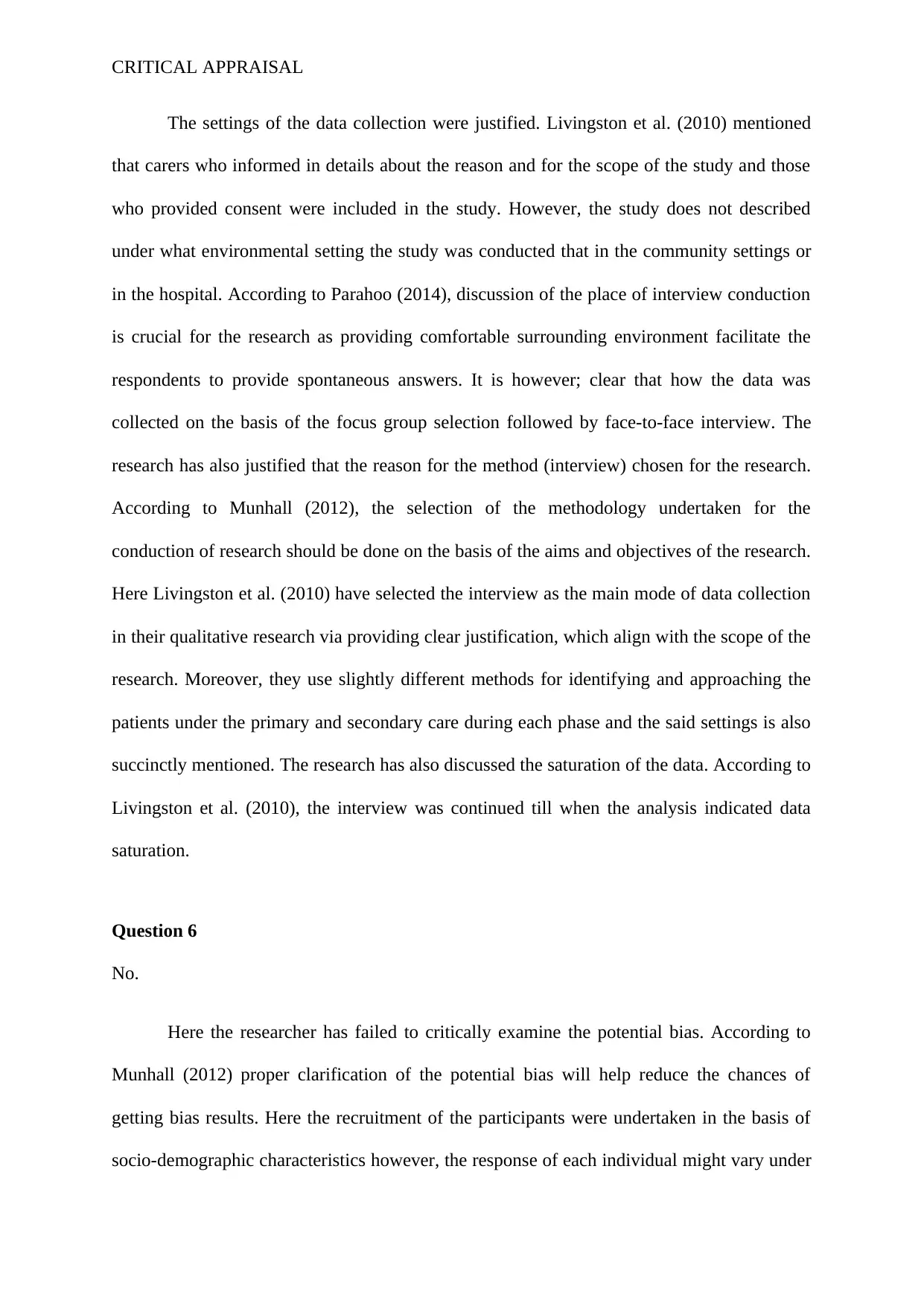
CRITICAL APPRAISAL
The settings of the data collection were justified. Livingston et al. (2010) mentioned
that carers who informed in details about the reason and for the scope of the study and those
who provided consent were included in the study. However, the study does not described
under what environmental setting the study was conducted that in the community settings or
in the hospital. According to Parahoo (2014), discussion of the place of interview conduction
is crucial for the research as providing comfortable surrounding environment facilitate the
respondents to provide spontaneous answers. It is however; clear that how the data was
collected on the basis of the focus group selection followed by face-to-face interview. The
research has also justified that the reason for the method (interview) chosen for the research.
According to Munhall (2012), the selection of the methodology undertaken for the
conduction of research should be done on the basis of the aims and objectives of the research.
Here Livingston et al. (2010) have selected the interview as the main mode of data collection
in their qualitative research via providing clear justification, which align with the scope of the
research. Moreover, they use slightly different methods for identifying and approaching the
patients under the primary and secondary care during each phase and the said settings is also
succinctly mentioned. The research has also discussed the saturation of the data. According to
Livingston et al. (2010), the interview was continued till when the analysis indicated data
saturation.
Question 6
No.
Here the researcher has failed to critically examine the potential bias. According to
Munhall (2012) proper clarification of the potential bias will help reduce the chances of
getting bias results. Here the recruitment of the participants were undertaken in the basis of
socio-demographic characteristics however, the response of each individual might vary under
The settings of the data collection were justified. Livingston et al. (2010) mentioned
that carers who informed in details about the reason and for the scope of the study and those
who provided consent were included in the study. However, the study does not described
under what environmental setting the study was conducted that in the community settings or
in the hospital. According to Parahoo (2014), discussion of the place of interview conduction
is crucial for the research as providing comfortable surrounding environment facilitate the
respondents to provide spontaneous answers. It is however; clear that how the data was
collected on the basis of the focus group selection followed by face-to-face interview. The
research has also justified that the reason for the method (interview) chosen for the research.
According to Munhall (2012), the selection of the methodology undertaken for the
conduction of research should be done on the basis of the aims and objectives of the research.
Here Livingston et al. (2010) have selected the interview as the main mode of data collection
in their qualitative research via providing clear justification, which align with the scope of the
research. Moreover, they use slightly different methods for identifying and approaching the
patients under the primary and secondary care during each phase and the said settings is also
succinctly mentioned. The research has also discussed the saturation of the data. According to
Livingston et al. (2010), the interview was continued till when the analysis indicated data
saturation.
Question 6
No.
Here the researcher has failed to critically examine the potential bias. According to
Munhall (2012) proper clarification of the potential bias will help reduce the chances of
getting bias results. Here the recruitment of the participants were undertaken in the basis of
socio-demographic characteristics however, the response of each individual might vary under
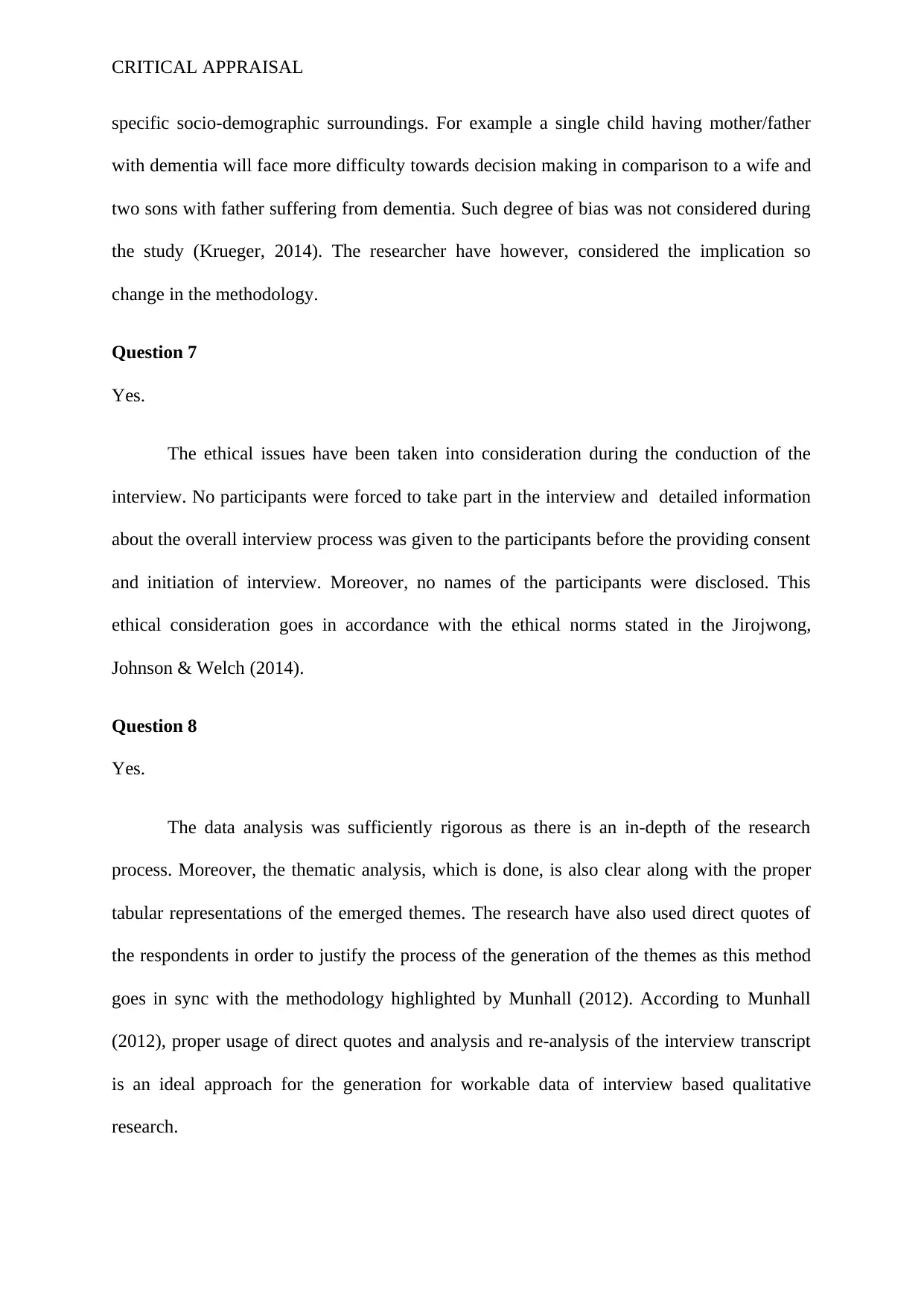
CRITICAL APPRAISAL
specific socio-demographic surroundings. For example a single child having mother/father
with dementia will face more difficulty towards decision making in comparison to a wife and
two sons with father suffering from dementia. Such degree of bias was not considered during
the study (Krueger, 2014). The researcher have however, considered the implication so
change in the methodology.
Question 7
Yes.
The ethical issues have been taken into consideration during the conduction of the
interview. No participants were forced to take part in the interview and detailed information
about the overall interview process was given to the participants before the providing consent
and initiation of interview. Moreover, no names of the participants were disclosed. This
ethical consideration goes in accordance with the ethical norms stated in the Jirojwong,
Johnson & Welch (2014).
Question 8
Yes.
The data analysis was sufficiently rigorous as there is an in-depth of the research
process. Moreover, the thematic analysis, which is done, is also clear along with the proper
tabular representations of the emerged themes. The research have also used direct quotes of
the respondents in order to justify the process of the generation of the themes as this method
goes in sync with the methodology highlighted by Munhall (2012). According to Munhall
(2012), proper usage of direct quotes and analysis and re-analysis of the interview transcript
is an ideal approach for the generation for workable data of interview based qualitative
research.
specific socio-demographic surroundings. For example a single child having mother/father
with dementia will face more difficulty towards decision making in comparison to a wife and
two sons with father suffering from dementia. Such degree of bias was not considered during
the study (Krueger, 2014). The researcher have however, considered the implication so
change in the methodology.
Question 7
Yes.
The ethical issues have been taken into consideration during the conduction of the
interview. No participants were forced to take part in the interview and detailed information
about the overall interview process was given to the participants before the providing consent
and initiation of interview. Moreover, no names of the participants were disclosed. This
ethical consideration goes in accordance with the ethical norms stated in the Jirojwong,
Johnson & Welch (2014).
Question 8
Yes.
The data analysis was sufficiently rigorous as there is an in-depth of the research
process. Moreover, the thematic analysis, which is done, is also clear along with the proper
tabular representations of the emerged themes. The research have also used direct quotes of
the respondents in order to justify the process of the generation of the themes as this method
goes in sync with the methodology highlighted by Munhall (2012). According to Munhall
(2012), proper usage of direct quotes and analysis and re-analysis of the interview transcript
is an ideal approach for the generation for workable data of interview based qualitative
research.
⊘ This is a preview!⊘
Do you want full access?
Subscribe today to unlock all pages.

Trusted by 1+ million students worldwide
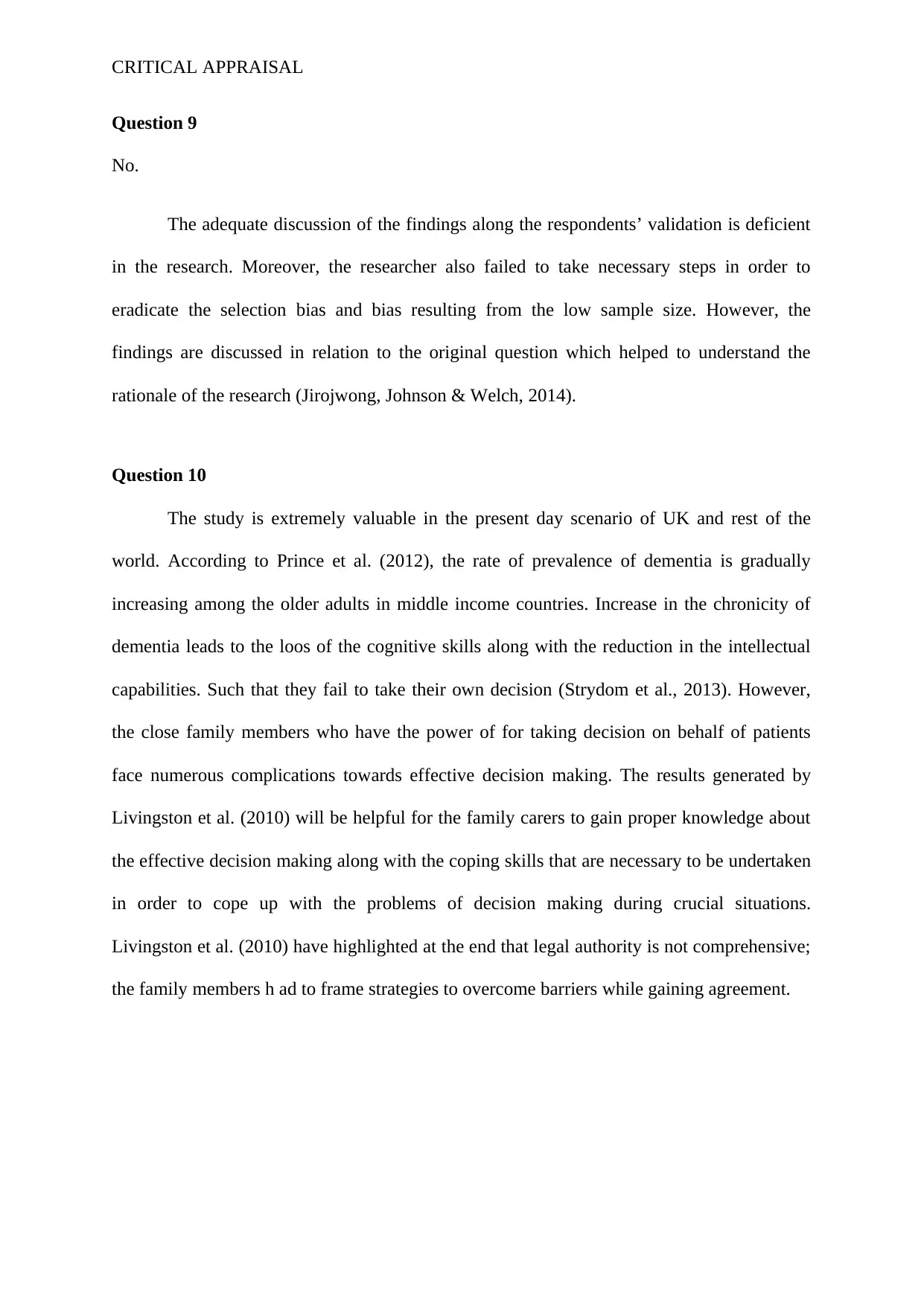
CRITICAL APPRAISAL
Question 9
No.
The adequate discussion of the findings along the respondents’ validation is deficient
in the research. Moreover, the researcher also failed to take necessary steps in order to
eradicate the selection bias and bias resulting from the low sample size. However, the
findings are discussed in relation to the original question which helped to understand the
rationale of the research (Jirojwong, Johnson & Welch, 2014).
Question 10
The study is extremely valuable in the present day scenario of UK and rest of the
world. According to Prince et al. (2012), the rate of prevalence of dementia is gradually
increasing among the older adults in middle income countries. Increase in the chronicity of
dementia leads to the loos of the cognitive skills along with the reduction in the intellectual
capabilities. Such that they fail to take their own decision (Strydom et al., 2013). However,
the close family members who have the power of for taking decision on behalf of patients
face numerous complications towards effective decision making. The results generated by
Livingston et al. (2010) will be helpful for the family carers to gain proper knowledge about
the effective decision making along with the coping skills that are necessary to be undertaken
in order to cope up with the problems of decision making during crucial situations.
Livingston et al. (2010) have highlighted at the end that legal authority is not comprehensive;
the family members h ad to frame strategies to overcome barriers while gaining agreement.
Question 9
No.
The adequate discussion of the findings along the respondents’ validation is deficient
in the research. Moreover, the researcher also failed to take necessary steps in order to
eradicate the selection bias and bias resulting from the low sample size. However, the
findings are discussed in relation to the original question which helped to understand the
rationale of the research (Jirojwong, Johnson & Welch, 2014).
Question 10
The study is extremely valuable in the present day scenario of UK and rest of the
world. According to Prince et al. (2012), the rate of prevalence of dementia is gradually
increasing among the older adults in middle income countries. Increase in the chronicity of
dementia leads to the loos of the cognitive skills along with the reduction in the intellectual
capabilities. Such that they fail to take their own decision (Strydom et al., 2013). However,
the close family members who have the power of for taking decision on behalf of patients
face numerous complications towards effective decision making. The results generated by
Livingston et al. (2010) will be helpful for the family carers to gain proper knowledge about
the effective decision making along with the coping skills that are necessary to be undertaken
in order to cope up with the problems of decision making during crucial situations.
Livingston et al. (2010) have highlighted at the end that legal authority is not comprehensive;
the family members h ad to frame strategies to overcome barriers while gaining agreement.
Paraphrase This Document
Need a fresh take? Get an instant paraphrase of this document with our AI Paraphraser
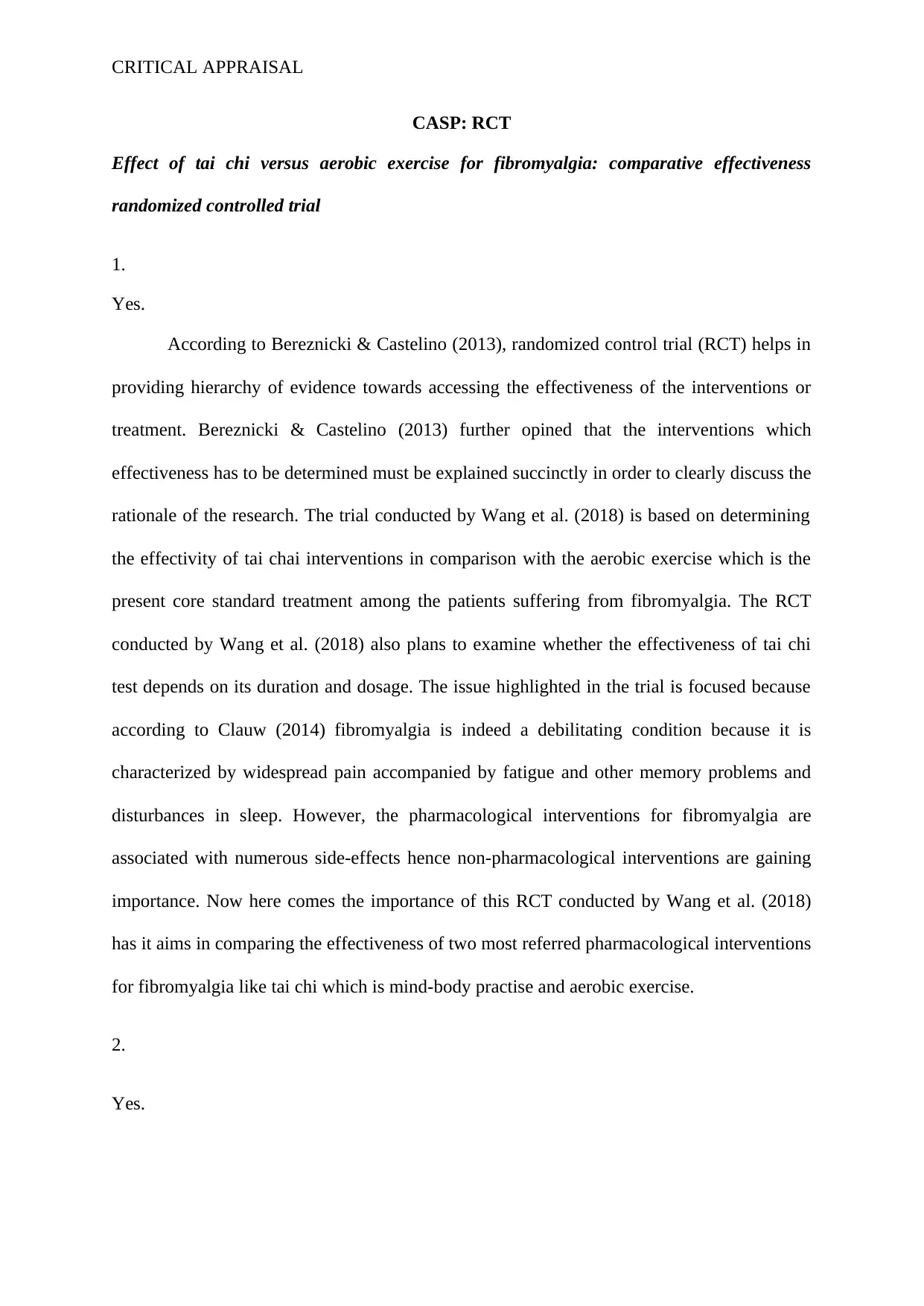
CRITICAL APPRAISAL
CASP: RCT
Effect of tai chi versus aerobic exercise for fibromyalgia: comparative effectiveness
randomized controlled trial
1.
Yes.
According to Bereznicki & Castelino (2013), randomized control trial (RCT) helps in
providing hierarchy of evidence towards accessing the effectiveness of the interventions or
treatment. Bereznicki & Castelino (2013) further opined that the interventions which
effectiveness has to be determined must be explained succinctly in order to clearly discuss the
rationale of the research. The trial conducted by Wang et al. (2018) is based on determining
the effectivity of tai chai interventions in comparison with the aerobic exercise which is the
present core standard treatment among the patients suffering from fibromyalgia. The RCT
conducted by Wang et al. (2018) also plans to examine whether the effectiveness of tai chi
test depends on its duration and dosage. The issue highlighted in the trial is focused because
according to Clauw (2014) fibromyalgia is indeed a debilitating condition because it is
characterized by widespread pain accompanied by fatigue and other memory problems and
disturbances in sleep. However, the pharmacological interventions for fibromyalgia are
associated with numerous side-effects hence non-pharmacological interventions are gaining
importance. Now here comes the importance of this RCT conducted by Wang et al. (2018)
has it aims in comparing the effectiveness of two most referred pharmacological interventions
for fibromyalgia like tai chi which is mind-body practise and aerobic exercise.
2.
Yes.
CASP: RCT
Effect of tai chi versus aerobic exercise for fibromyalgia: comparative effectiveness
randomized controlled trial
1.
Yes.
According to Bereznicki & Castelino (2013), randomized control trial (RCT) helps in
providing hierarchy of evidence towards accessing the effectiveness of the interventions or
treatment. Bereznicki & Castelino (2013) further opined that the interventions which
effectiveness has to be determined must be explained succinctly in order to clearly discuss the
rationale of the research. The trial conducted by Wang et al. (2018) is based on determining
the effectivity of tai chai interventions in comparison with the aerobic exercise which is the
present core standard treatment among the patients suffering from fibromyalgia. The RCT
conducted by Wang et al. (2018) also plans to examine whether the effectiveness of tai chi
test depends on its duration and dosage. The issue highlighted in the trial is focused because
according to Clauw (2014) fibromyalgia is indeed a debilitating condition because it is
characterized by widespread pain accompanied by fatigue and other memory problems and
disturbances in sleep. However, the pharmacological interventions for fibromyalgia are
associated with numerous side-effects hence non-pharmacological interventions are gaining
importance. Now here comes the importance of this RCT conducted by Wang et al. (2018)
has it aims in comparing the effectiveness of two most referred pharmacological interventions
for fibromyalgia like tai chi which is mind-body practise and aerobic exercise.
2.
Yes.
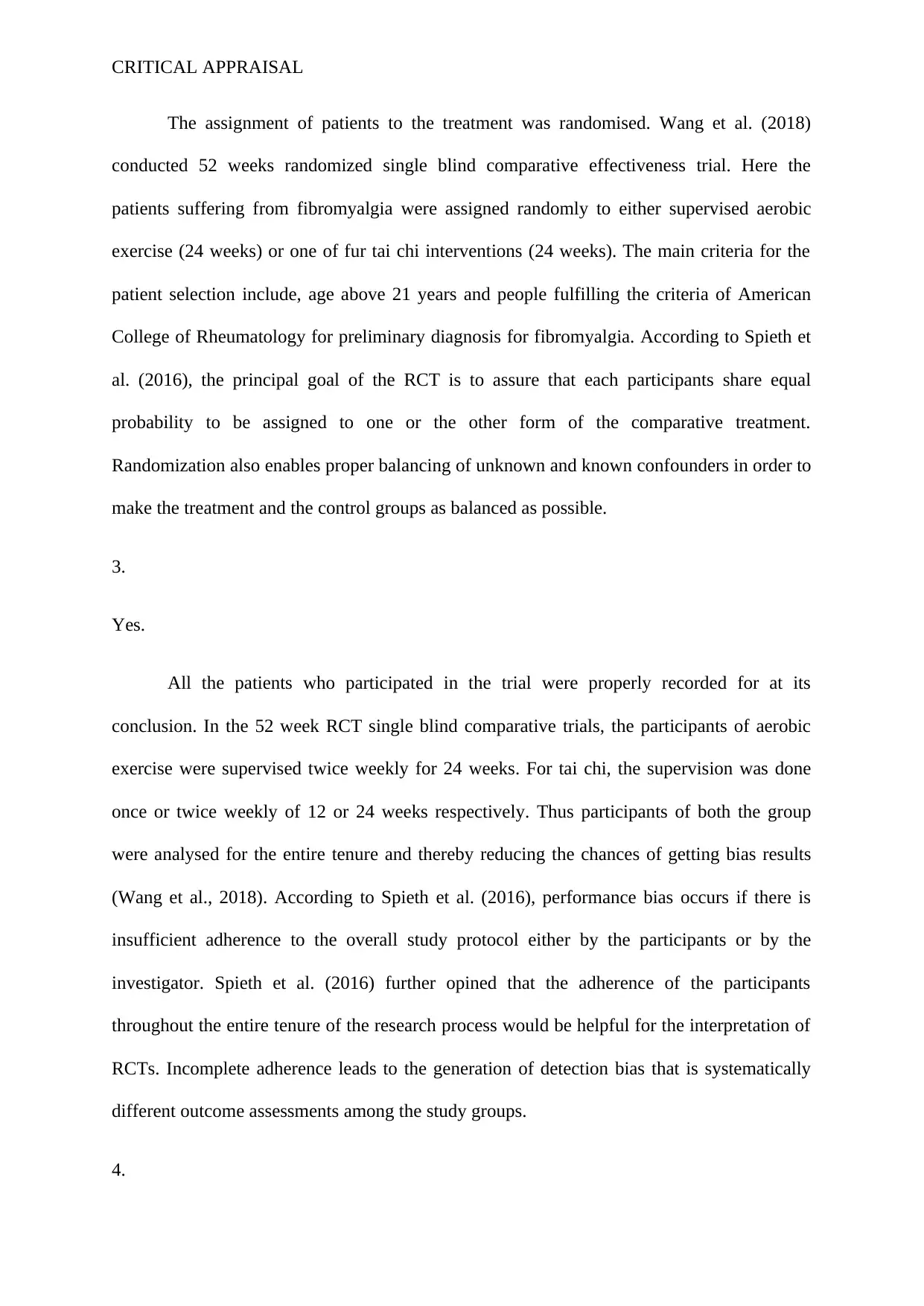
CRITICAL APPRAISAL
The assignment of patients to the treatment was randomised. Wang et al. (2018)
conducted 52 weeks randomized single blind comparative effectiveness trial. Here the
patients suffering from fibromyalgia were assigned randomly to either supervised aerobic
exercise (24 weeks) or one of fur tai chi interventions (24 weeks). The main criteria for the
patient selection include, age above 21 years and people fulfilling the criteria of American
College of Rheumatology for preliminary diagnosis for fibromyalgia. According to Spieth et
al. (2016), the principal goal of the RCT is to assure that each participants share equal
probability to be assigned to one or the other form of the comparative treatment.
Randomization also enables proper balancing of unknown and known confounders in order to
make the treatment and the control groups as balanced as possible.
3.
Yes.
All the patients who participated in the trial were properly recorded for at its
conclusion. In the 52 week RCT single blind comparative trials, the participants of aerobic
exercise were supervised twice weekly for 24 weeks. For tai chi, the supervision was done
once or twice weekly of 12 or 24 weeks respectively. Thus participants of both the group
were analysed for the entire tenure and thereby reducing the chances of getting bias results
(Wang et al., 2018). According to Spieth et al. (2016), performance bias occurs if there is
insufficient adherence to the overall study protocol either by the participants or by the
investigator. Spieth et al. (2016) further opined that the adherence of the participants
throughout the entire tenure of the research process would be helpful for the interpretation of
RCTs. Incomplete adherence leads to the generation of detection bias that is systematically
different outcome assessments among the study groups.
4.
The assignment of patients to the treatment was randomised. Wang et al. (2018)
conducted 52 weeks randomized single blind comparative effectiveness trial. Here the
patients suffering from fibromyalgia were assigned randomly to either supervised aerobic
exercise (24 weeks) or one of fur tai chi interventions (24 weeks). The main criteria for the
patient selection include, age above 21 years and people fulfilling the criteria of American
College of Rheumatology for preliminary diagnosis for fibromyalgia. According to Spieth et
al. (2016), the principal goal of the RCT is to assure that each participants share equal
probability to be assigned to one or the other form of the comparative treatment.
Randomization also enables proper balancing of unknown and known confounders in order to
make the treatment and the control groups as balanced as possible.
3.
Yes.
All the patients who participated in the trial were properly recorded for at its
conclusion. In the 52 week RCT single blind comparative trials, the participants of aerobic
exercise were supervised twice weekly for 24 weeks. For tai chi, the supervision was done
once or twice weekly of 12 or 24 weeks respectively. Thus participants of both the group
were analysed for the entire tenure and thereby reducing the chances of getting bias results
(Wang et al., 2018). According to Spieth et al. (2016), performance bias occurs if there is
insufficient adherence to the overall study protocol either by the participants or by the
investigator. Spieth et al. (2016) further opined that the adherence of the participants
throughout the entire tenure of the research process would be helpful for the interpretation of
RCTs. Incomplete adherence leads to the generation of detection bias that is systematically
different outcome assessments among the study groups.
4.
⊘ This is a preview!⊘
Do you want full access?
Subscribe today to unlock all pages.

Trusted by 1+ million students worldwide
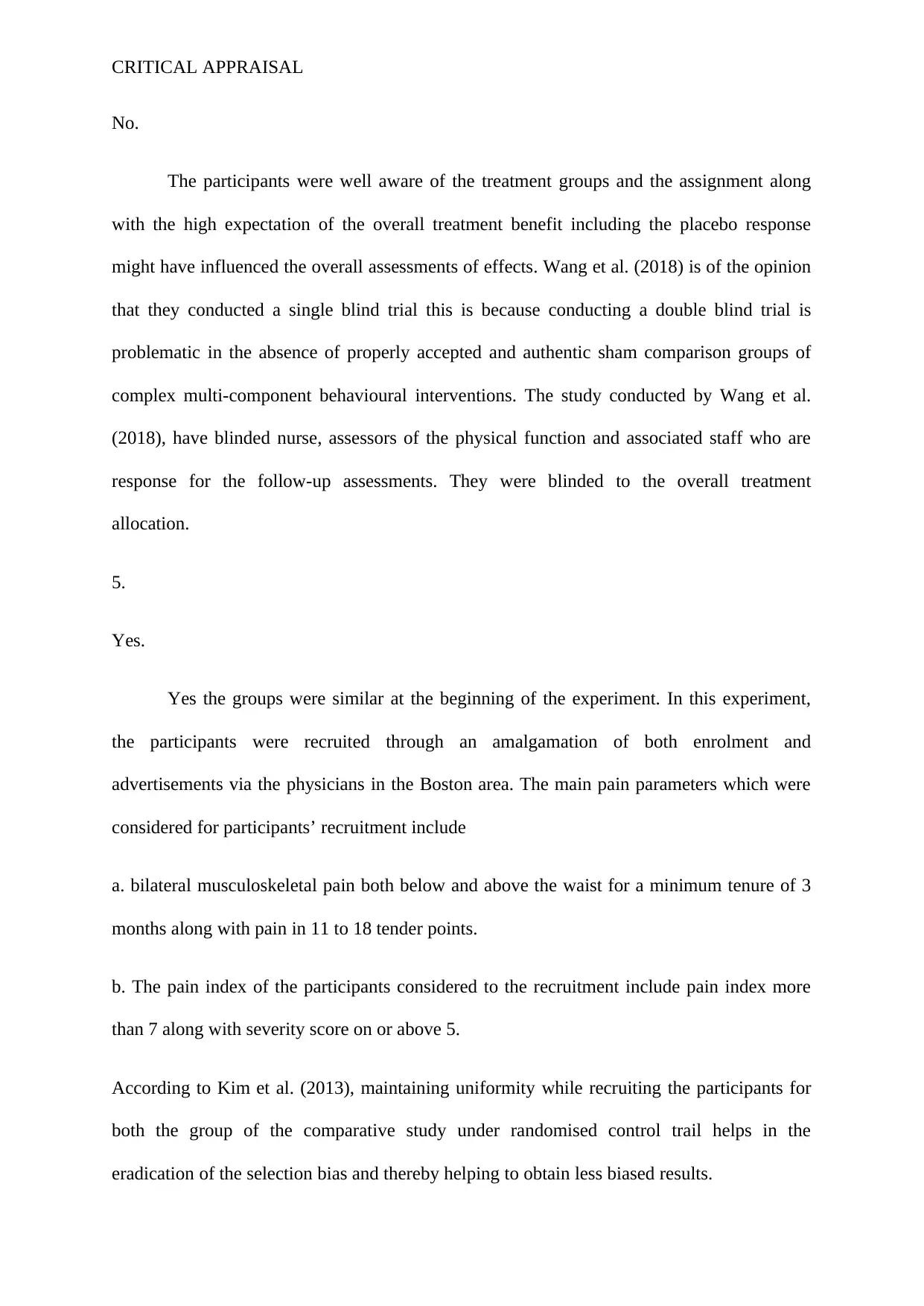
CRITICAL APPRAISAL
No.
The participants were well aware of the treatment groups and the assignment along
with the high expectation of the overall treatment benefit including the placebo response
might have influenced the overall assessments of effects. Wang et al. (2018) is of the opinion
that they conducted a single blind trial this is because conducting a double blind trial is
problematic in the absence of properly accepted and authentic sham comparison groups of
complex multi-component behavioural interventions. The study conducted by Wang et al.
(2018), have blinded nurse, assessors of the physical function and associated staff who are
response for the follow-up assessments. They were blinded to the overall treatment
allocation.
5.
Yes.
Yes the groups were similar at the beginning of the experiment. In this experiment,
the participants were recruited through an amalgamation of both enrolment and
advertisements via the physicians in the Boston area. The main pain parameters which were
considered for participants’ recruitment include
a. bilateral musculoskeletal pain both below and above the waist for a minimum tenure of 3
months along with pain in 11 to 18 tender points.
b. The pain index of the participants considered to the recruitment include pain index more
than 7 along with severity score on or above 5.
According to Kim et al. (2013), maintaining uniformity while recruiting the participants for
both the group of the comparative study under randomised control trail helps in the
eradication of the selection bias and thereby helping to obtain less biased results.
No.
The participants were well aware of the treatment groups and the assignment along
with the high expectation of the overall treatment benefit including the placebo response
might have influenced the overall assessments of effects. Wang et al. (2018) is of the opinion
that they conducted a single blind trial this is because conducting a double blind trial is
problematic in the absence of properly accepted and authentic sham comparison groups of
complex multi-component behavioural interventions. The study conducted by Wang et al.
(2018), have blinded nurse, assessors of the physical function and associated staff who are
response for the follow-up assessments. They were blinded to the overall treatment
allocation.
5.
Yes.
Yes the groups were similar at the beginning of the experiment. In this experiment,
the participants were recruited through an amalgamation of both enrolment and
advertisements via the physicians in the Boston area. The main pain parameters which were
considered for participants’ recruitment include
a. bilateral musculoskeletal pain both below and above the waist for a minimum tenure of 3
months along with pain in 11 to 18 tender points.
b. The pain index of the participants considered to the recruitment include pain index more
than 7 along with severity score on or above 5.
According to Kim et al. (2013), maintaining uniformity while recruiting the participants for
both the group of the comparative study under randomised control trail helps in the
eradication of the selection bias and thereby helping to obtain less biased results.
Paraphrase This Document
Need a fresh take? Get an instant paraphrase of this document with our AI Paraphraser
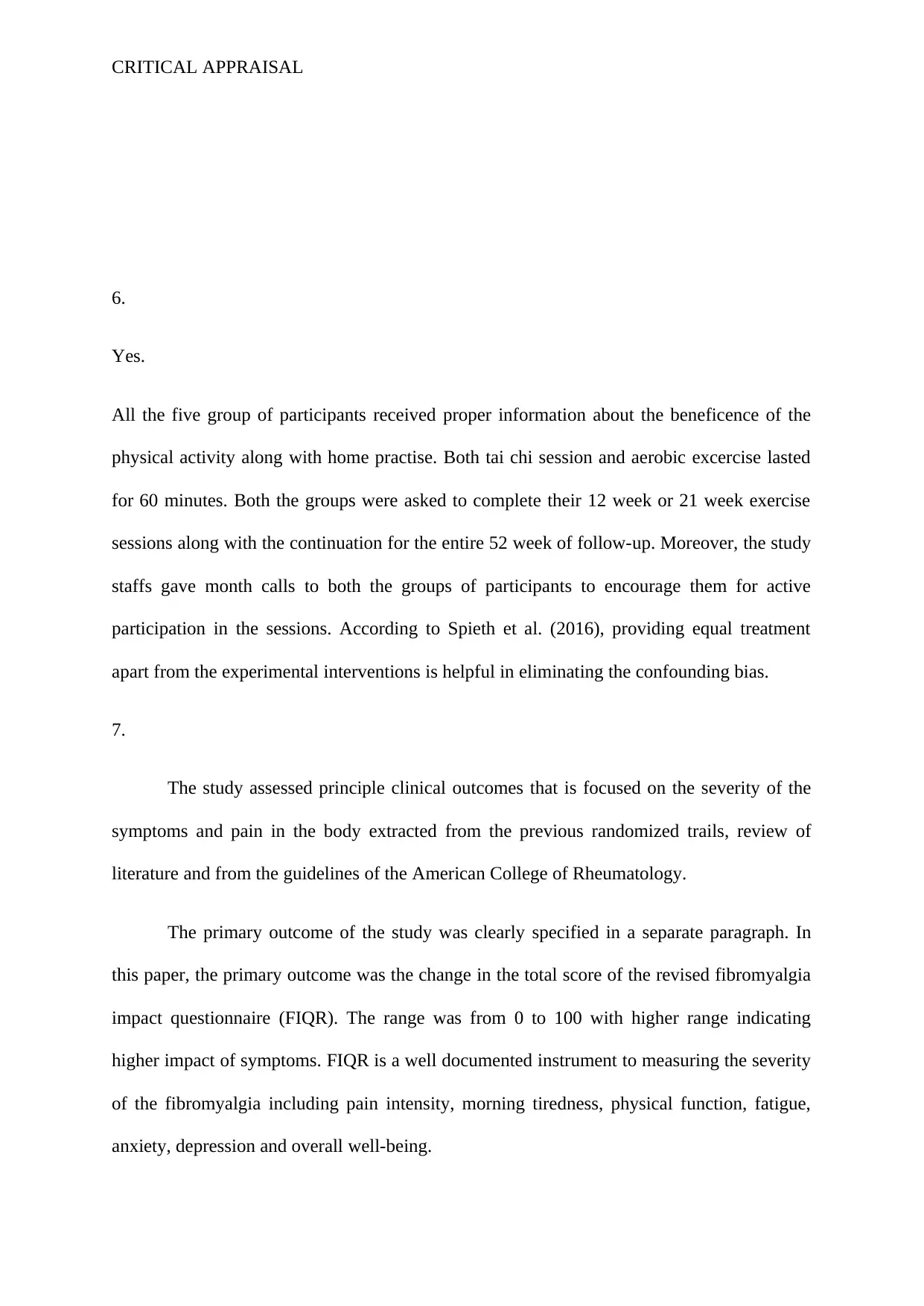
CRITICAL APPRAISAL
6.
Yes.
All the five group of participants received proper information about the beneficence of the
physical activity along with home practise. Both tai chi session and aerobic excercise lasted
for 60 minutes. Both the groups were asked to complete their 12 week or 21 week exercise
sessions along with the continuation for the entire 52 week of follow-up. Moreover, the study
staffs gave month calls to both the groups of participants to encourage them for active
participation in the sessions. According to Spieth et al. (2016), providing equal treatment
apart from the experimental interventions is helpful in eliminating the confounding bias.
7.
The study assessed principle clinical outcomes that is focused on the severity of the
symptoms and pain in the body extracted from the previous randomized trails, review of
literature and from the guidelines of the American College of Rheumatology.
The primary outcome of the study was clearly specified in a separate paragraph. In
this paper, the primary outcome was the change in the total score of the revised fibromyalgia
impact questionnaire (FIQR). The range was from 0 to 100 with higher range indicating
higher impact of symptoms. FIQR is a well documented instrument to measuring the severity
of the fibromyalgia including pain intensity, morning tiredness, physical function, fatigue,
anxiety, depression and overall well-being.
6.
Yes.
All the five group of participants received proper information about the beneficence of the
physical activity along with home practise. Both tai chi session and aerobic excercise lasted
for 60 minutes. Both the groups were asked to complete their 12 week or 21 week exercise
sessions along with the continuation for the entire 52 week of follow-up. Moreover, the study
staffs gave month calls to both the groups of participants to encourage them for active
participation in the sessions. According to Spieth et al. (2016), providing equal treatment
apart from the experimental interventions is helpful in eliminating the confounding bias.
7.
The study assessed principle clinical outcomes that is focused on the severity of the
symptoms and pain in the body extracted from the previous randomized trails, review of
literature and from the guidelines of the American College of Rheumatology.
The primary outcome of the study was clearly specified in a separate paragraph. In
this paper, the primary outcome was the change in the total score of the revised fibromyalgia
impact questionnaire (FIQR). The range was from 0 to 100 with higher range indicating
higher impact of symptoms. FIQR is a well documented instrument to measuring the severity
of the fibromyalgia including pain intensity, morning tiredness, physical function, fatigue,
anxiety, depression and overall well-being.
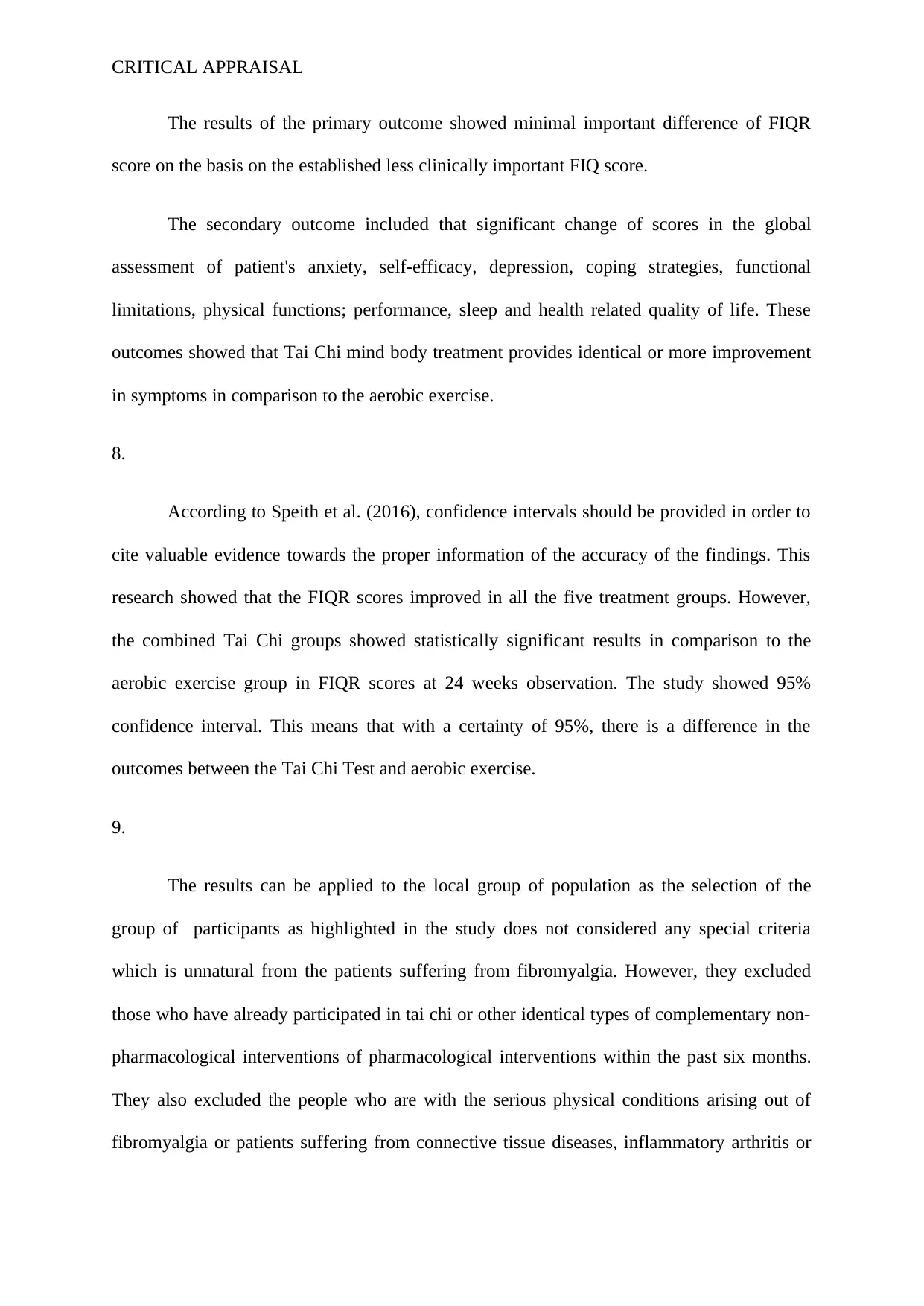
CRITICAL APPRAISAL
The results of the primary outcome showed minimal important difference of FIQR
score on the basis on the established less clinically important FIQ score.
The secondary outcome included that significant change of scores in the global
assessment of patient's anxiety, self-efficacy, depression, coping strategies, functional
limitations, physical functions; performance, sleep and health related quality of life. These
outcomes showed that Tai Chi mind body treatment provides identical or more improvement
in symptoms in comparison to the aerobic exercise.
8.
According to Speith et al. (2016), confidence intervals should be provided in order to
cite valuable evidence towards the proper information of the accuracy of the findings. This
research showed that the FIQR scores improved in all the five treatment groups. However,
the combined Tai Chi groups showed statistically significant results in comparison to the
aerobic exercise group in FIQR scores at 24 weeks observation. The study showed 95%
confidence interval. This means that with a certainty of 95%, there is a difference in the
outcomes between the Tai Chi Test and aerobic exercise.
9.
The results can be applied to the local group of population as the selection of the
group of participants as highlighted in the study does not considered any special criteria
which is unnatural from the patients suffering from fibromyalgia. However, they excluded
those who have already participated in tai chi or other identical types of complementary non-
pharmacological interventions of pharmacological interventions within the past six months.
They also excluded the people who are with the serious physical conditions arising out of
fibromyalgia or patients suffering from connective tissue diseases, inflammatory arthritis or
The results of the primary outcome showed minimal important difference of FIQR
score on the basis on the established less clinically important FIQ score.
The secondary outcome included that significant change of scores in the global
assessment of patient's anxiety, self-efficacy, depression, coping strategies, functional
limitations, physical functions; performance, sleep and health related quality of life. These
outcomes showed that Tai Chi mind body treatment provides identical or more improvement
in symptoms in comparison to the aerobic exercise.
8.
According to Speith et al. (2016), confidence intervals should be provided in order to
cite valuable evidence towards the proper information of the accuracy of the findings. This
research showed that the FIQR scores improved in all the five treatment groups. However,
the combined Tai Chi groups showed statistically significant results in comparison to the
aerobic exercise group in FIQR scores at 24 weeks observation. The study showed 95%
confidence interval. This means that with a certainty of 95%, there is a difference in the
outcomes between the Tai Chi Test and aerobic exercise.
9.
The results can be applied to the local group of population as the selection of the
group of participants as highlighted in the study does not considered any special criteria
which is unnatural from the patients suffering from fibromyalgia. However, they excluded
those who have already participated in tai chi or other identical types of complementary non-
pharmacological interventions of pharmacological interventions within the past six months.
They also excluded the people who are with the serious physical conditions arising out of
fibromyalgia or patients suffering from connective tissue diseases, inflammatory arthritis or
⊘ This is a preview!⊘
Do you want full access?
Subscribe today to unlock all pages.

Trusted by 1+ million students worldwide
1 out of 16
Related Documents
Your All-in-One AI-Powered Toolkit for Academic Success.
+13062052269
info@desklib.com
Available 24*7 on WhatsApp / Email
![[object Object]](/_next/static/media/star-bottom.7253800d.svg)
Unlock your academic potential
Copyright © 2020–2025 A2Z Services. All Rights Reserved. Developed and managed by ZUCOL.





